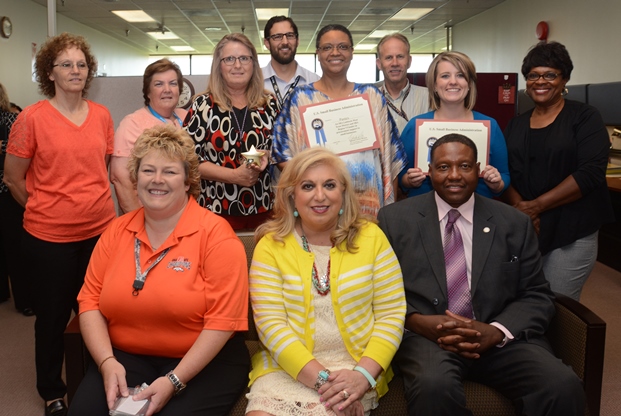Pantex Blog
Pantex supports March of Dimes
Pantex was a proud presenting sponsor of the recent March of Dimes Golf Tournament that took place Aug. 22. CNS contributed $8,000 to benefit the goal of healthy babies and mothers in the area. The annual golf tournament is a popular event among Pantexans. “Not only were we able to have a good time, we were able to support a great cause,” said Todd Ailes, Pantex deputy site manager.

Kenny Steward, Pantex quality operations director, knows the significance of being able to give and how it drives Pantexans to participate in multiple events throughout the year. “As one of the largest employers in the Amarillo area, it is important for us to give back to our community and support many of our charities both local and national,” Steward said. “It was an honor to be one of the 60+ employees to represent CNS and the Pantex Plant at the March of Dimes Golf Tournament.” Steward added that being a part of the first‑place team for the third flight was a nice way to top off the event. Pantexans who participated signed a commemorative banner and received a complimentary golf towel courtesy of CNS.
| Notable team results with Pantex participants | ||
| 1st Flight | 2nd Flight | 3rd Flight |
|---|---|---|
| 2nd Place Mike Smith Corey Boyd Bob McWaters Rick Allford |
3rd Place Paul Diaz Sr. Paul Diaz Jr. Steven Diaz Cameron Diaz |
1st Place Joe Marshall Todd Ailes Bob Asbury Kenny Steward |
| 3rd Place Doug Cruz Curt Hinz Jerry Tenorio Frank George |
2nd Place Jimmy Ramirez Harry West Tim Alvarado Arnold Galbraith |
|
| 6th Place Danny Sena Pat Sena Roger Williams Gary Haynie |
5th Place Tyson Sherwood Detrik Sherwood Grant Singleton Brad Henston |
|
| Long Drive # 18 A.M. — David Vasquez | ||
SBA recognizes Pantex as a leader
The Pantex Plant’s Supply Chain Management organization recently received three awards from the Small Business Administration.
Pantex received the following awards:
- SBA leader in the Lubbock-West Texas District and the SBA Region VI (comprised of Texas, New Mexico, Oklahoma, Arkansas and Louisiana),
- Provider of outstanding stellar access to procurement opportunities for small businesses and
- SBA Procurement All Star.
The awards were presented by SBA Region VI District Director Calvin Davis and Regional Administrator Yolanda Garcia Olivarez.
Pantex has a long history of working with small business. Kelly Delgado-Goudschaal, acting manager of Supply Chain Management said, “These awards are a direct reflection of the dedication and the commitment of the Procurement personnel at Pantex. We have had a long-standing tradition of supporting small businesses within our community. We also work with the West Texas Procurement Center to develop and mentor small businesses within our community.”
Achieving the subcontracting goal is part of the plan. “We have an established goal each year as to the amount of dollars to be awarded to small businesses, and we work with a variety of organizations, such as those with expertise in special tooling, packaging and fuels,” according to Compliance team lead Barbara Smith. Consolidated Nuclear Security, LLC has a small business subcontracting goal of 65 percent for the plant.
Smith added, “It is an honor to be recognized by SBA as a leader for promoting small businesses. For the past seven years, we have consistently exceeded our small business goal. Pantexans continue to support SBA initiatives by identifying small businesses with which we can contract.”

Small Business Administration Region VI SBA District Director Calvin Davis and Regional Administrator Yolanda Garcia Olivarez recently presented awards to Pantex’s Supply Chain Management organization. Featured in photo, front row, from left, Kelly Delgado-Goudschaal, Olivarez and Davis. Back row from left, Frances Tillery, Barbara Smith, Teresa Albus, Jeff Gillmore, Tammi Pedro, Randy Lucas, Ashley Hayton and Diane Johnson.
CNS and Metal Trades Council reach new labor agreement
Consolidated Nuclear Security (CNS) was informed by the Metal Trades Council (MTC) that a new four-year labor agreement has been ratified for work at the Pantex Plant. CNS is appreciative that the negotiations and work stoppage are resolved, and Pantex looks forward to all employees represented by MTC returning to work on October 5, 2015.
Reminders for employees returning to work October 5:
- Pantex managers and supervisors will be contacting employees represented by the MTC with instructions on where to report.
- The Pantex Plant is open for normal operations. All personnel are to report for duty according to their regularly assigned schedules.
- Continue to exercise caution as you approach the Plant and slow down to prevent accidents or injuries.
- Safety and security remain top priority. All security and medical reporting requirements remain in place. Also, please remember not to bring Personal Electronic Devices into prohibited areas.
CNS supports women in STEM luncheon
Since the 1940s when they traded in their aprons for coveralls and gas masks, women have played a key role at the Pantex Plant. To honor their past contributions and celebrate the work they currently perform, Consolidated Nuclear Security, LLC was a corporate sponsor of the recent 2015 Louise Daniel Women’s History Luncheon and Women’s Equality Day Celebration.
The sponsorship was fitting because this year’s event highlighted the work done by women in science, technology, engineering and math (STEM) fields.
Natalie Waters, a Pantex industrial engineer, spoke about the history of local women in STEM and presented a vignette about female STEM professionals at Pantex.
“Young girls and women who live in the Panhandle today should be proud of the women pioneers who worked hard, paved the way and excelled in their STEM fields,” said Waters.
The annual event is named for Louise Daniel, a local science teacher and civic volunteer. Before her death in 2003, Daniel requested that her friends create an event to remind women of all ages about women’s historic struggles to achieve equality.
Six years ago, her friends honored this last wish by creating a women’s history lecture fund at the Amarillo College Foundation. They host a lecture and luncheon in August to coincide with Women’s Equality Day, focusing on a different facet of women’s history each year.

Pantex industrial engineer Natalie Waters, Ph.D., was a keynote speaker at the Louise Daniel Women’s History Luncheon. Pantex scientists and engineers attending the event included (from left) Rachel Ehler, Hannah Pemberton, Isela Galan, Erin Robinson, Raquel Barrera-Chavez, Halianne Crawford, Waters, Brandy Ramirez, Meagan Brown, Courtney Waddell, Karishma Myers, Jessie Phifer, Zelda Martinez and Ava Azores.
The people behind HEPF: Mitch Carry

Mitch Carry, startup manager, of the High Explosives Pressing Facility, has been a part of the project since it began.
The plan to improve the current process for manufacturing high explosives at the Pantex Plant has been in the works since 2002. The current facilities date back to the 1960s, and the equipment involved in pressing is aging and nearing the end of its service life. The current high explosive pressing process occurs in multiple facilities across the plant. The completion of the High Explosives Pressing Facility consolidates all of these processes in one building.
Mitch Carry, startup manager, has been a part of the HEPF since the project began. Carry’s role is to make sure all the required work is completed to guarantee compliance with the appropriate contract requirements for startup and safe operations. This role requires that he have a broad understanding of plant requirements and their associated regulations. It also requires that he work closely with many of the plant organizations to get the work accomplished. When there are problems, he is responsible for working with the right people to resolve the issues.
A major component in guaranteeing compliance is compiling the “objective evidence” or documentation showing that all products satisfy the requirements and prove that the facility is constructed according to strict specifications.
“We have to have documentation for all aspects of the construction,” Carry said. “For example, when you’re placing concrete, you have to be able to prove you installed the rebar correctly, properly mixed and placed the concrete, and then successfully tested the strength of the concrete in accordance with the requirements.” Proving the work was done correctly is no small feat, considering the new facility has about 8,000 yards of concrete, delivered at an average of 9 yards per truck and installed in more than 55 separate placements. “Assembling the records for each placement creates a pedigree for the final product,” he said.
The newly constructed High Explosives Pressing Facility at Pantex will consolidate and improve operations.
Whether it’s the concrete, fire extinguishers, blast doors or even the HE presses, the documents and reports that go with each item are important, and Pantex must be able to produce documentation showing that all aspects of the facility operate safely.
“The basic function of the documentation is to ensure that the facility operates safely and as designed,” said David Crump, director of Pantex Projects Management.
Being able to show that the facility is up to current NNSA regulations is a pivotal step when it comes to getting the facility ready to be occupied, and Carry’s role ensures that part of the process goes as smoothly as possible.
“He has to make sure that all of the facility and the construction and installation documentation that goes with it are available for review by the startup team,” Crump said. “Mitch is a very important to the success of the HEPF and making sure we are ready to go through the readiness process.”
Hope Wallace, project manager, collaborates with Carry by supporting the work involved in the startup process. “Mitch takes a very active role as the startup manager.” Wallace said. “He has to assemble the entire team, and he knows that it takes the whole team to get the project finished.” Even with a project of this scale, great leaders know the importance of keeping up the morale. Carry makes a point to do his best to minimize the stress levels.
“With such a long and important project, there is a lot of pressure placed on everyone, but Mitch knows that you still have to be able to have fun, and your work has to be enjoyable. He does a great job of taking off some of that pressure and it helps the team to keep moving forward,” Wallace said.
While the startup effort on a project this size is daunting, the end result will be a state-of-the-art facility unlike any other. Not only will the new HEPF replace the current, outdated facilities, it will also allow employees to work in an environment designed specifically for this type of work.
“This facility was designed and built for high explosives processing. The whole facility is compliant with all current high explosive processing regulations required by NNSA,” said Carry.
Carry emphasized that one of the most important aspects of the HEPF is how streamlined it will make the process of pressing high explosives, which, in turn, allows for higher production.
“We are looking at our key performance parameters effectively tripling production.” Not only does the new facility allow for greater production, having everything housed in one area will decrease the amount of time Transportation has to spend moving the high explosives. This will help cut down their workload and allow Transportation to focus on other activities, Carry said.
With all of the state-of-the-art equipment and consideration that went into the design of the HEPF, Carry said that the real reason this facility will be so successful is the people who have been involved in the entire process. “There are a lot of good people working on this project, and they know the importance of making it successful. They are the reason for this facility’s success.”
